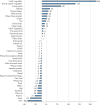Translation of nutrient recommendations into personalized optimal diets for Chinese urban lactating women by linear programming models
- PMID: 30227842
- PMCID: PMC6145120
- DOI: 10.1186/s12884-018-2008-6
Translation of nutrient recommendations into personalized optimal diets for Chinese urban lactating women by linear programming models
Abstract
Background: Lactating women need to consume a high-quality diet to replete nutrient stores depleted during pregnancy and to ensure sufficient nutrition for breastfeeding. However, several studies reported suboptimal dietary quality and nutrient intake of lactating mothers in China. The objectives of this study was to apply dietary modeling method to develop individualized optimal diets, which meet the nutrient requirements for lactating women in urban China.
Methods: Data were collected from a sample of 576 lactating women from 0 to 240 days postpartum during the Maternal Infant Nutrition Growth study conducted between 2011 and 2012 in three cities including Beijing, Guangzhou, and Suzhou. Dietary intake data were collected with an interviewer-administered 24-h survey. Linear programming was applied to develop dietary plans that meet recommendations for lactation women in the China Dietary Reference Intakes 2013 and the Chinese Dietary Guideline 2016, while with least deviation from the observed dietary intake.
Results: Through dietary modeling, individual optimal diets were developed for 576 lactating women. The optimal diets met all the food and nutrient intake constraints set in the linear programming models. The large difference between observed and optimized diets suggests that the nutrient needs of lactating mothers in China may only be met after substantial dietary changes. In addition, the analysis showed that it was difficult to meet the recommended intake for six nutrients: vitamin A, vitamin B1, vitamin B6, calcium, selenium, and dietary fiber. Moreover, four clusters in the optimized diets were identified by K-means cluster analysis. The four clusters confirmed that the optimal diets developed by linear programming could characterize the variety in dietary habits by geographical regions and duration of lactation.
Conclusion: Linear programming could help translate nutrient recommendations into personal diet advices for a sample of urban lactating mothers from China. The study showed that dietary modeling is helpful to support healthy eating of lactation women by translating dietary guidelines into personalized meal plans.
Trial registration: The Maternal Infant Nutrition Growth study was registered in ClinicalTrials.gov with identifier NCT01971671 . Registration date October 29, 2013.
Keywords: Lactation mother; Linear programming; Nutrient recommendation; Personalized optimal diets.
Conflict of interest statement
Ethics approval and consent to participate
This study was conducted according to the guidelines in the Declaration of Helsinki. All procedures involving human participants were approved by the Medical Ethics Research Board of Peking University (NO.IRB00001052–11042). Written informed consents were obtained from all participants. The registration number of the MING study in ClinicalTrials.gov is NCT01971671.
Consent for publication
Not applicable.
Competing interest
Co-author WL is employed by Nestlé Nutrition Institute and co-author KY is employed by Nestlé Research Center. There are no patents, products in development or marketed products to declare.
Publisher’s Note
Springer Nature remains neutral with regard to jurisdictional claims in published maps and institutional affiliations.
Figures
Similar articles
-
Nutrient Intake Among Lactating Women With Overweight and Obesity in Norway: A Comparison With the Nordic Nutrition Recommendations 2023.J Hum Nutr Diet. 2025 Feb;38(1):e70000. doi: 10.1111/jhn.70000. J Hum Nutr Diet. 2025. PMID: 39763277 Free PMC article.
-
Assessment of Dietary Intake and Nutrient Gaps, and Development of Food-Based Recommendations, among Pregnant and Lactating Women in Zinder, Niger: An Optifood Linear Programming Analysis.Nutrients. 2019 Jan 2;11(1):72. doi: 10.3390/nu11010072. Nutrients. 2019. PMID: 30609695 Free PMC article.
-
Evaluation of dietary intake of lactating women in China and its potential impact on the health of mothers and infants.BMC Womens Health. 2012 Jul 16;12:18. doi: 10.1186/1472-6874-12-18. BMC Womens Health. 2012. PMID: 22800437 Free PMC article.
-
Estimating energy and nutrient intakes in studies of human fertility.J Biosoc Sci. 1992 Jul;24(3):335-45. doi: 10.1017/s0021932000019891. J Biosoc Sci. 1992. PMID: 1634562 Review.
-
Onset and evolution of stunting in infants and children. Examples from the Human Nutrition Collaborative Research Support Program. Kenya and Egypt studies.Eur J Clin Nutr. 1994 Feb;48 Suppl 1:S90-102. Eur J Clin Nutr. 1994. PMID: 8005095 Review.
Cited by
-
Dietary intake in lactating mothers in China 2018: report of a survey.Nutr J. 2020 Jul 14;19(1):72. doi: 10.1186/s12937-020-00589-x. Nutr J. 2020. PMID: 32664937 Free PMC article.
-
Adjusting DBI-2016 to dietary balance index for Chinese maternal women and assessing the association between maternal dietary quality and postpartum weight retention: A longitudinal study.PLoS One. 2020 Aug 20;15(8):e0237225. doi: 10.1371/journal.pone.0237225. eCollection 2020. PLoS One. 2020. PMID: 32817619 Free PMC article.
-
Analysis of dietary patterns and nutritional adequacy in lactating women: a multicentre European cohort (ATLAS study).J Nutr Sci. 2021 Mar 11;10:e17. doi: 10.1017/jns.2021.7. eCollection 2021. J Nutr Sci. 2021. PMID: 33889400 Free PMC article.
-
Utilization of a Diet Optimization Model in Ensuring Adequate Intake among Pregnant Women in Selangor, Malaysia.Int J Environ Res Public Health. 2019 Nov 27;16(23):4720. doi: 10.3390/ijerph16234720. Int J Environ Res Public Health. 2019. PMID: 31783474 Free PMC article.
-
Pregnancy, thyroid, and the potential use of selenium.Hormones (Athens). 2020 Mar;19(1):47-53. doi: 10.1007/s42000-019-00144-2. Epub 2019 Nov 13. Hormones (Athens). 2020. PMID: 31721136 Free PMC article. Review.
References
-
- Hanson Mark A., Bardsley Anne, De-Regil Luz Maria, Moore Sophie E., Oken Emily, Poston Lucilla, Ma Ronald C., McAuliffe Fionnuala M., Maleta Ken, Purandare Chittaranjan N., Yajnik Chittaranjan S., Rushwan Hamid, Morris Jessica L. The International Federation of Gynecology and Obstetrics (FIGO) recommendations on adolescent, preconception, and maternal nutrition: “Think Nutrition First”#. International Journal of Gynecology & Obstetrics. 2015;131:S213. doi: 10.1016/S0020-7292(15)30034-5. - DOI - PubMed
MeSH terms
Associated data
LinkOut - more resources
Full Text Sources
Other Literature Sources
Medical
Miscellaneous


